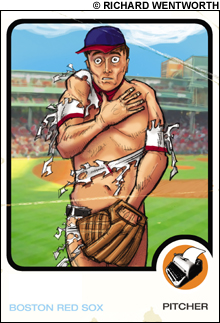 Last week was an important moment in the history of American journalism. After reading the explosive steroids-scandal book Game of Shadows, written by two San Francisco Chronicle reporters, baseball commissioner Bud Selig finally emerged from his cocoon of denial to announce an investigation into the performance-enhancing drugs that have cast a cloud over the sport and particularly over San Francisco Giant Barry Bonds, who is 47 home runs away from catching all-time leader Hank Aaron.
Last week was an important moment in the history of American journalism. After reading the explosive steroids-scandal book Game of Shadows, written by two San Francisco Chronicle reporters, baseball commissioner Bud Selig finally emerged from his cocoon of denial to announce an investigation into the performance-enhancing drugs that have cast a cloud over the sport and particularly over San Francisco Giant Barry Bonds, who is 47 home runs away from catching all-time leader Hank Aaron.
As the scandal has gradually grown from a whisper to a public preoccupation, the media’s role in keeping steroid abuse out of the spotlight for so many years has come under increased scrutiny. Sure, the players, Major League Baseball, and the union all share a huge bulk of the culpability. But there were also reporters who got long hard looks (often literally, via clubhouse access) at the many manifestations of steroid use — quick and massive muscle growth, pimple-strewn backs — without being willing or able to blow the whistle.
In a finger-pointing column, media critic Jon Friedman argued that “the media should have been more aggressive in covering Bonds’s alleged drug-taking over the past few years.... His saga was — literally — right in front of their noses.”
Last Saturday, ESPN’s Buster Olney, writing in the New York Times, offered a modified mea culpa, admitting that because of his failure to do a better job poking around on that story, “I had a role in baseball’s institutional failure during what will be forever known as the Steroid Era.”
As it turns out, the two Game of Shadows journalists — Mark Fainaru-Wada and Lance Williams (who have already won a slew of honors for their coverage, including theprestigious George Polk Award) — are not the kind of reporters found walking around post-game clubhouses armed with microphones and notebooks. Fainaru-Wada, a former sportswriter, was working on a campaign-finance project for the Chronicle’s investigative unit when the BALCO (Bay Area Laboratory Co-operative) drug story broke. Williams, a traditional courts-and-cops reporter, is a long-time investigative journalist.
The fact that it took two reporters outside of the sports department to help unearth what may be the darkest moment in baseball since the 1919 Black Sox scandal raises a critical issue. In this era when steroid use generates Congressional hearings and ball clubs are immensely influential community institutions and powerful economic entities, why does so much sports reporting still consider itself — to use a descriptive term — the “toy department”?
In fact, a survey of sports sections in 16 US newspapers released last year by the Project for Excellence in Journalism concluded that they are generally “a passive and reactive space … with little room for enterprise reportage.” The study found that planned events — such as games — made up nearly 90 percent of the stories examined, while 10 percent could be characterized as newsroom-initiated or enterprise coverage.